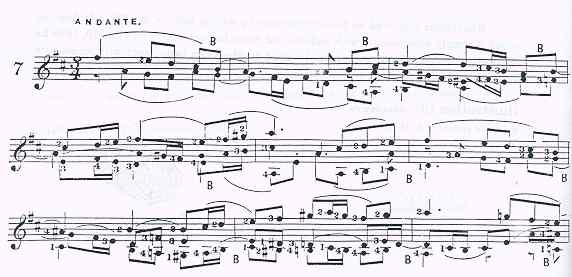
Example 1. Giulio Regondi, Andante for solo concertina, No. 7
from Regondi's Second Method Book for Concertina, measures 1-9.
Published in 1857 by Wessel and Co., 229 Regent Street, London.
by Henry Doktorski
© 1998
In England, the concertina became accepted as a concert instrument, largely due to the efforts of the great concertina virtuoso and composer, Giulio Regondi (1822-1872). He was a child prodigy on the guitar and by the time he was eight years old had performed for most of the courts of Europe. At the age of nine, Regondi started learning the concertina and, after four years of study, began performing it in public, creating a sensation. He shared the stage with such renowned performers as Mendelssohn, Clara Schumann, Thalberg and Moscheles. During the height of his fame he was commissioning and performing new soli and concerti (six in all) by well-known composers.

The British composer, Joseph Warren (1804-1881) also wrote music for the concertina. His Grand Fantasy on 'Deh! con te, con te li prendi' from Bellini's opera Norma, was premiered by the young Regondi during his first public concertina performance — at the Birmingham Music Festival in September 1837 — which featured Felix Mendelssohn with his St. Paul Oratorio. Warren also wrote Great Fantasia for concertina and piano which was published in 1855.
The composer and virtuoso violinist, Wilhelm Bernhard Molique (1802-1869), was famous in his day for his Lieder, which were regarded as highly as Schubert's, but he also wrote music for concertina, including two concerti and numerous collections of songs for concertina and piano, as well as harp. Molique's music was not only extremely popular in the legitimate concert hall, but also in the salons where people of taste gathered to hear performances for small groups in elegantly appointed private rooms.
Other nineteenth-century composers of concertina music were Sir George Alexander Macfarren, J. F. Barnett, Julius Benedict and Edward Silas, who wrote an adagio for eight concertinas, trios, a quartet and a quintet for combination of concertina, strings and pianoforte, and many other works for concertina and pianoforte, including two sonatas.
Concertina bands became popular in England (especially in the northern mining towns) and St. Petersburg Russia (in the late 1870's). Instruments were made in three sizes (treble, tenor-treble and baritone) enabling the performance of quartets played from string parts.
After several decades of "the golden age" of the concertina, the tastes of society began to change and the instrument gradually became unfashionable to classical audiences, in no small part due to the scorn inflicted upon it by influential critics such as Henry Chorley and Hector Berlioz. Although Regondi's virtuosity and abilities had not diminished, public opinion had, and so he retired at the end of 1869. He died of cancer two-and-a-half years later. His music was quickly forgotten, not to be re-discovered for over one hundred years.
Theophile Dalbert stated that the classical concertina "was ultimately the victim of its own popular appeal. After mass production began . . . the instrument abandoned the rarified aristocratic salons of France for the dance-floors of the countryside."
As the classical concertina declined in popularity among educated classical music circles, the accordion rose in popularity among the common uneducated masses. Wagner wrote, "From its Austrian hometown on the Danube [Vienna, 1829] it traveled to Paris a year later and then arrived in Germany where in the Saxon town of Klingenthal an important accordion building center arose. Soon this was challenged by a growing industry in Italy at Castelfidardo and in Russia at Tula. Twenty years after its invention, tens of thousands of squeezeboxes were sold every year. The instrument was everywhere. The accordion craze had started."
Wagner continued, "The new instrument's popularity was a result of its unique qualities. Firstly, it was much louder than all the older folk instruments put together. It could easily be heard in even the wildest pub above the stomping of dancing feet. It was also the prototype of a 'one man band' with bass and chords on the left-hand side and buttons for the melody on the right, and you could still sing along and beat the rhythm with your feet. The instrument needed no tuning and was always ready to play, but the most ingenious thing about the early one-row squeezebox was that you couldn't play it really badly. Even if you lost the melody it still sounded fine."
Beginning from its birth in 1829, the accordion increasingly became associated with proletarian dance music, far removed from the serious performances in the concert halls and music academies. Macerollo wrote, "The accordion as patented by Demian . . . in its folk environment inevitably led to the stigma of the accordion as a 'toy' or 'folk' instrument." Thus began an association which continues to the present day.
| Back to History of the Free-Reed Instruments |
| Back to The Classical Free-Reed, Inc. Home Page |